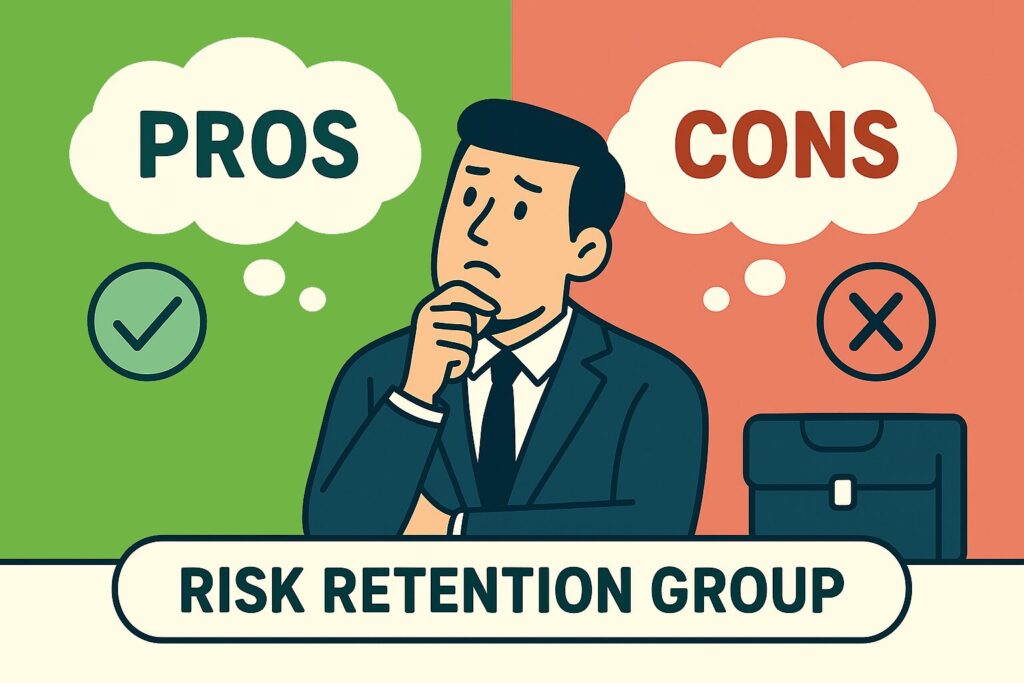Understanding the Pros and Cons of a Risk Retention Group

Navigating insurance options can be challenging, especially when exploring alternatives like RRG insurance. But what exactly is a risk retention group, and what does RRG stand for?
In simple terms, a risk retention group (RRG) is a liability insurance company owned directly by its members, typically commercial businesses sharing similar risk profiles. This “risk retention meaning” emphasizes members managing their own risks collectively.
Formed under the Liability Risk Retention Act of 1986, these groups offer an alternative to traditional insurance models. Members often enjoy lower premiums, customized coverage, and greater control over their liability coverage decisions.
However, risk retention groups have their challenges as well. This article examines both the advantages and drawbacks, helping you determine if an RRG aligns with your insurance needs.
What is a Risk Retention Group?

A risk retention group definition, as outlined by the Liability Risk Retention Act, describes a state-chartered insurance company owned by its insured members. Unlike traditional insurers, an RRG specifically provides liability insurance for its members, who generally belong to a homogenous industry group.
Members pool their resources, forming a stable financial foundation. Together, they manage professional liability, product liability, general liability, and directors and officers liability risks. However, RRGs do not offer workers’ compensation or personal lines like auto liability coverage.
RRGs operate across state lines once chartered, with fewer regulatory obstacles compared to traditional insurance companies. This streamlined approach often leads to more relevant and cost-effective coverage.
How Risk Retention Groups Function
Formation and Membership
Risk retention group formation begins when businesses identify a common need for specialized liability insurance. Members must first secure a charter as a state-chartered insurance company. Following charter approval, the RRG can offer consistent liability coverage across multiple states.
Membership typically requires businesses from a similar industry—such as healthcare, construction, or transportation—to commit capital. This collective financial backing is essential for financial solvency and risk-based capital management.
Additionally, members benefit from cooperative risk management strategies, enhancing loss control efforts and sharing expertise. These factors help achieve underwriting profits, which may translate into dividends or lower premiums.
Insurance Coverage Options
RRGs specialize in liability coverage, focusing on professional liability, product liability, general liability, and directors and officers liability insurance. They also commonly offer errors & omissions insurance, protecting members from claims arising from negligent services or errors.
Coverage customization is a hallmark of risk retention insurance. Policies adapt to reflect changing member needs, market conditions, or emerging risks. However, unlike mutual companies or traditional insurers, RRGs do not provide personal or workers’ compensation insurance.
Advantages of Risk Retention Groups

Cost Savings
Joining a risk retention group can significantly lower costs compared to traditional insurers. Members share administrative expenses, eliminate unnecessary features, and avoid traditional insurers’ higher overheads and profit margins. This approach frees resources for reinvestment into the business or additional risk management.
Customized Insurance Solutions
RRGs excel in offering tailored insurance solutions for commercial businesses with specialized risks. By focusing exclusively on liability lines, they provide policies precisely matched to members’ specific risks, industry dynamics, and regulatory requirements.
Enhanced Control Over Claims
RRG membership grants significant influence over claims management. Unlike traditional insurers, members actively shape claims procedures, promoting transparency and fairness. Shared experiences within the group enhance proactive claims handling and improve overall loss control outcomes.
Disadvantages of Risk Retention Groups

Limited Risk Pooling
A primary drawback of risk retention groups is their limited risk pooling, given members share similar industry risks. Events impacting one member may simultaneously affect others, creating financial strain. This homogeneity also complicates actuarial analysis, potentially leading to unpredictable premium adjustments.
Regulatory Challenges
Despite reduced regulatory barriers across state lines, RRGs face strict domiciliary state regulations and must comply with NAIC accreditation standards. Navigating these complex regulatory landscapes can lead to operational inefficiencies, added expenses, and challenges in expansion.
Potential for Financial Instability
Due to their limited size and narrow membership base, RRGs risk financial instability during significant claim events. Unlike traditional insurers, RRGs lack access to state guaranty funds, amplifying the financial impact of adverse conditions. Members must regularly review annual financial statements and maintain robust actuarial analysis to ensure ongoing financial health.
Conclusion: Weighing the Benefits and Risks of RRG

Risk retention groups offer compelling advantages such as cost savings, customized liability coverage, and greater control over claims management. When comparing a risk retention group vs captive insurer or a risk retention group vs insurance company, the flexibility of cross-state operations and tailored policies often favor the RRG model.
Yet, notable challenges like limited risk pooling, stringent regulatory scrutiny, and potential financial volatility exist. Businesses must thoroughly analyze these factors, considering their financial solvency needs, long-term rate stability, and comfort with alternative risk transfer methods.
Ultimately, carefully evaluating the RRG model’s suitability relative to a company’s specific risk profile ensures an informed and strategic insurance decision.

